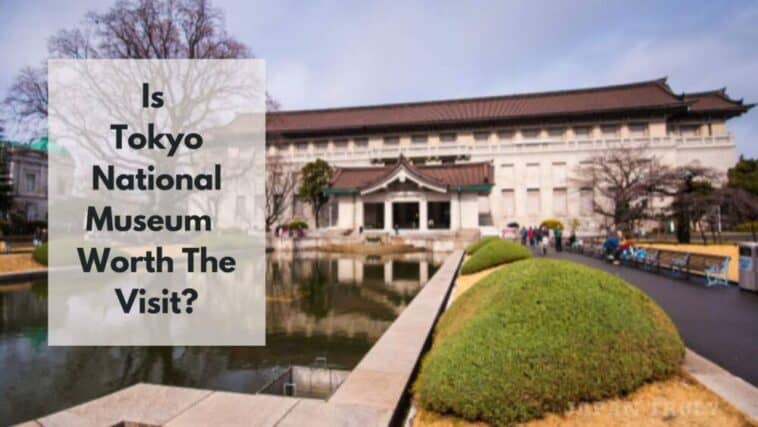Is Tokyo National Museum worth it? Find out in this comprehensive guide, which covers everything from the museum’s collection to its admission price.
The Tokyo National Museum is the largest and oldest museum in Japan, and it houses one of the most comprehensive collections of Japanese art and artifacts in the world.
With over 110,000 objects on display, the museum covers everything from Japanese prehistory to the modern era.
So, is the Tokyo National Museum worth visiting? The answer is a resounding yes! The museum is a must-see for anyone interested in Japanese culture and history.

But even if you’re not a Japan expert, you’re sure to be impressed by the museum’s vast and varied collection.
In this article, we’ll take a closer look at the Tokyo National Museum and explore what it has to offer visitors. We’ll also cover the museum’s admission price and provide some tips for making the most of your visit.
Page Contents
Is Tokyo National Museum Worth It?
Yes, Tokyo National Museum is definitely worth a visit. It houses a vast and diverse collection of Japanese art and historical artifacts that provide a fascinating glimpse into Japan’s rich cultural heritage.
From exquisite artwork to masterful craftsmanship, the museum showcases the best of Japanese culture. Its educational programs, serene gardens, and convenient location in Ueno Park make it a must-visit destination for tourists and locals alike.
Whether you’re an art enthusiast, a history buff, or simply curious about Japan’s past, the Tokyo National Museum offers a captivating and enriching experience that will leave you with a deeper appreciation for the country’s cultural legacy.

A Glimpse into Japan’s Storied Past at Tokyo National Museum
The Tokyo National Museum houses an extensive collection of art and historical artifacts that span thousands of years. Its exhibits provide visitors with a unique opportunity to take a chronological journey through Japan’s storied past, from ancient times to the modern era.
Whether you are interested in samurai armor, exquisite kimono, or religious sculptures, the museum’s comprehensive collection has something to offer everyone.
- Related: Is Tokyo Dome Worth It?
Experience World-Class Art and Craftsmanship at Tokyo National Museum
Tokyo National Museum is renowned for its unparalleled collection of traditional Japanese art and craftsmanship, which is a testament to the nation’s artistic prowess and cultural heritage.
Here are some key aspects that make this aspect of the museum special:
- Diverse Art Forms: The museum’s collection includes a wide array of art forms, such as painting, sculpture, ceramics, textiles, and calligraphy. Visitors can explore the rich tapestry of Japanese artistry and creativity across various mediums.

- Historical Significance: Many of the artworks and crafts on display have historical significance, providing insights into the aesthetics and artistic techniques of different periods in Japan’s history. From ancient Jomon pottery to Edo-period ukiyo-e woodblock prints, each piece tells a story about the culture and society of its time.
- Masterpieces: Tokyo National Museum houses some of Japan’s most celebrated masterpieces. Visitors can view iconic works like Katsushika Hokusai’s “Great Wave off Kanagawa” and Ogata Kōrin’s “Red and White Plum Blossoms” up close, appreciating the intricate details and artistic genius behind these creations.
- Skill and Precision: The craftsmanship on display is characterized by an extraordinary level of skill and precision. For instance, samurai armor exhibits meticulous metalwork, intricate lacquer detailing, and expert leathercraft, showcasing the artistry that went into creating these functional yet beautifully adorned suits.
- Evolution of Techniques: The museum’s collection also highlights the evolution of artistic techniques and styles over the centuries. Visitors can observe how artistic trends changed with shifts in culture, religion, and technology, offering a comprehensive view of Japan’s artistic development.
- Cultural Significance: Each piece in the collection carries cultural significance, often tied to Japanese rituals, traditions, and beliefs. For example, religious sculptures provide insights into the spiritual practices of different periods, while traditional kimono and textiles reflect the country’s fashion and textile heritage.
- Global Influence: Tokyo National Museum demonstrates how Japanese art and craftsmanship have influenced and been influenced by other cultures. It showcases the fusion of indigenous traditions with foreign elements, particularly from China and Korea, demonstrating Japan’s openness to cultural exchange.
In summary, Tokyo National Museum’s “World-Class Art and Craftsmanship” section is special because it offers visitors an opportunity to immerse themselves in the exquisite world of Japanese artistry.
With its diverse collection, historical significance, and masterful execution, the museum provides a unique lens through which to appreciate the depth and beauty of Japanese culture and artistic heritage.
- Related: Is Mario Kart In Tokyo Worth It?
Find Cultural Diversity in One Place
Japan’s history is marked by a rich tapestry of cultures and influences, including indigenous Shinto beliefs, Buddhism from China and Korea, and cultural exchanges with neighboring countries.
The Tokyo National Museum reflects this diversity by displaying artifacts from different periods and regions of Japan.
You can explore the distinct cultural elements that have shaped the nation and appreciate the interconnectedness of Japanese culture with the wider world.
Tokyo National Museum is an Architectural Beauty
The museum’s architecture itself is a work of art. The main building, designed in the Meiji period, boasts an elegant blend of traditional Japanese and Western architectural styles.
Its serene gardens, complete with ponds and seasonal flora, provide a tranquil escape from the bustling city outside.
The well-preserved historic buildings also offer insights into the architectural heritage of Japan.
- Related: Is Tokyo Tower Worth It?
Find Educational Opportunities at Tokyo National Museum
For those interested in learning more about Japanese culture and history, the Tokyo National Museum offers a range of educational programs and guided tours. These resources help visitors gain a deeper understanding of the exhibits and their cultural significance.
Whether you’re a history enthusiast or a casual learner, the museum caters to all levels of interest and expertise.
Attend Temporary Exhibitions at Tokyo National Museum
In addition to its permanent collection, Tokyo National Museum frequently hosts temporary exhibitions, featuring a wide array of topics and artistic styles. These exhibitions provide fresh insights into Japan’s cultural heritage and often showcase rare and unique items not on permanent display.
Checking the museum’s schedule to see if any special exhibitions align with your interests can enhance your visit.
Convenient Location of Tokyo National Museum Makes It Super Accessible
Situated in Tokyo’s Ueno Park, the museum is conveniently located near other attractions such as Ueno Zoo, Ameya-Yokocho Market, and several other museums and cultural institutions.
A visit to Tokyo National Museum can easily be incorporated into a day of exploring Ueno Park, making it a convenient stop for tourists and locals alike.
What is special about Tokyo National Museum?
Tokyo National Museum stands out for its vast and diverse collection of Japanese art and historical artifacts, spanning thousands of years.
Its exhibits offer a chronological journey through Japan’s history, showcasing world-class craftsmanship, from delicate porcelain to masterful calligraphy and sculptures.
The museum’s architectural beauty and serene gardens provide a tranquil atmosphere, and it frequently hosts educational programs and temporary exhibitions.
Located in the heart of Tokyo’s Ueno Park, it’s easily accessible and conveniently situated near other attractions. Tokyo National Museum is a cultural treasure trove that offers visitors a unique opportunity to explore the rich tapestry of Japan’s cultural heritage.
Will kids enjoy the Tokyo National Museum?
While the Tokyo National Museum primarily caters to adults and older visitors with an interest in art and history, it can still be an enjoyable and educational experience for children, depending on their age and interests.
Here are some factors to consider when deciding if kids will enjoy the museum:
- Age: Younger children (under 6 or 7 years old) might have a limited attention span for the museum’s exhibits, as some of the artwork and historical artifacts may not engage them. However, older children, particularly those aged 8 and up, may have a better appreciation for the museum’s offerings.
- Interest: If your child has an interest in art, history, or Japanese culture, they are more likely to enjoy the museum. It can be helpful to introduce them to some aspects of Japanese history and art before the visit to spark their curiosity.
- Interactive Exhibits: While Tokyo National Museum is known for its traditional art and artifacts, it occasionally offers interactive exhibits and activities suitable for children. Check the museum’s website for any upcoming family-friendly programs or special exhibitions.
- Guided Tours: Consider joining a guided tour or using an audio guide if available. These resources can make the visit more engaging by providing context and stories behind the exhibits, which can be particularly helpful for children.
- Hands-On Workshops: Some museums offer hands-on workshops or activities for children. Inquire if the museum has any scheduled workshops or art-making sessions during your visit.
- Gardens: The museum’s gardens, including the teahouse, can provide a pleasant break for kids to explore and relax in a serene environment.
- Planning: Plan your visit strategically. Don’t try to see everything in one go. Focus on a few key exhibits or areas that might interest your child the most.
- Engaging Conversations: Encourage your child to ask questions and engage in discussions about what they see. This can help make the experience more interactive and educational.
- Snacks and Breaks: Bring some snacks and water, as well as take short breaks as needed to keep energy levels up.
How long should you spend at the Tokyo National Museum?
How long you should spend at the Tokyo National Museum depends on your interests and how much time you have available.
If you are only interested in seeing the most famous exhibits, such as the Gallery of Horyuji Treasures, you could spend as little as 30 minutes.
However, if you want to see a more comprehensive overview of Japanese art history, or if you are interested in specific areas of Japanese art, such as ceramics, painting, or sculpture, you could easily spend several hours or even a whole day at the museum.
Here is a suggested itinerary for a 2-hour visit to the Tokyo National Museum:
- Honkan: Start on the second floor of the Honkan, where you can see a chronological overview of Japanese art history. This is a good way to get a general sense of the museum’s collection.
- Japan Gallery: The Japan Gallery on the third floor of the Honkan has a more in-depth collection of Japanese art, from the prehistoric period to the present day.
- Gallery of Horyuji Treasures: This gallery houses a collection of priceless Buddhist artworks from the Horyuji Temple in Nara. These artworks are some of the oldest and most important examples of Japanese art in the world.
If you have more time, you can also visit the other buildings on the museum grounds, including the Toyokan, which has a collection of Asian art, and the Heiseikan, which has a collection of Japanese folk art.
How much does it cost to get into the Tokyo National Museum?
The cost of admission to the Tokyo National Museum depends on your age and nationality.
- Adults (over 18 years old): 1,000 yen
- University students (with student ID): 500 yen
- High school students, junior high school students, and elementary school students (with school ID): Free
- Persons under 18 years old and over 70 years old: Free
There are also discounts for groups of 20 or more people. You can purchase tickets online or at the museum entrance.
When is the best time to visit Tokyo national musuem?
The best time to visit the Tokyo National Museum is on a weekday morning during the shoulder seasons (spring and fall).
The museum is busiest on weekends and holidays, so if you can visit during the week, you’ll avoid the crowds and have a more enjoyable experience.
Here are some specific tips for visiting the Tokyo National Museum at the best time:
- Visit on a weekday morning: The museum opens at 9:00 AM, so arrive early to beat the crowds.
- Take advantage of the free admission days: The museum offers free admission on May 18th (National Museum Day) and on the second Sunday of every month.
- Avoid visiting during special exhibitions: Special exhibitions can attract large crowds, so it’s best to avoid visiting during these times.
- Consider visiting during the off-season: The museum is less crowded during the shoulder seasons (spring and fall) than it is during the peak summer and winter months.
If you can’t visit during the shoulder seasons or on a weekday morning, there are still a few things you can do to avoid the crowds:
- Visit in the afternoon: The museum is less crowded in the afternoon than it is in the morning.
- Visit on a weekday evening: The museum is open until 5:00 PM on weekdays, so you can visit in the evening to avoid the crowds.
- Take a guided tour: Guided tours are a great way to see the museum without having to worry about getting lost or missing anything.
No matter when you choose to visit, the Tokyo National Museum is a must-see for anyone interested in Japanese culture and history.
Conclusion
In conclusion, Tokyo National Museum is undoubtedly worth a visit for anyone interested in Japanese culture, history, and art. Its extensive collection, diverse exhibits, educational programs, and beautiful surroundings make it a cultural treasure trove in the heart of Tokyo.
Whether you are a history buff, an art aficionado, or simply a curious traveler, a trip to Tokyo National Museum promises an enriching and unforgettable experience.
It is a testament to Japan’s enduring cultural legacy and a place where the past comes alive, offering a deeper appreciation for the rich heritage of this remarkable nation.
My writing focuses on the various aspects of Japanese lifestyle, from traditional tea ceremonies and flower arrangement to modern fashion trends and pop culture. Through my articles, I aim to share my passion for Japan and provide readers with a glimpse into the rich and diverse world of Japanese culture.
I believe that the key to understanding Japanese lifestyle is to appreciate the balance between tradition and innovation. While Japan has a rich cultural heritage that dates back centuries, it is also a country that is constantly evolving and embracing new ideas and technologies.
Whether you’re interested in learning about the latest fashion trends in Tokyo, or want to explore the ancient art of calligraphy, my writing will take you on a journey through the many facets of Japanese lifestyle. So join me as we explore the beauty and complexity of this fascinating culture together!





